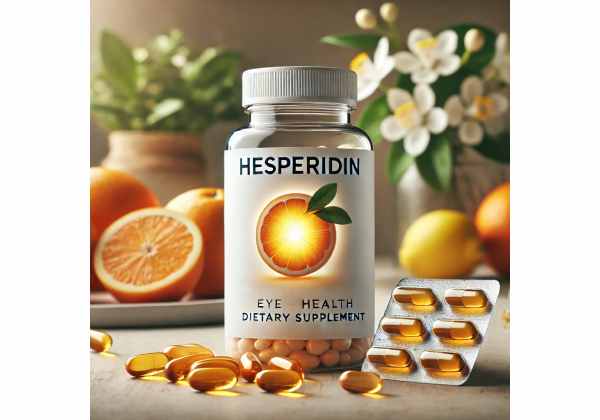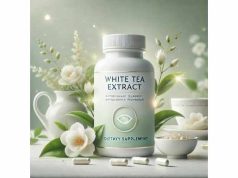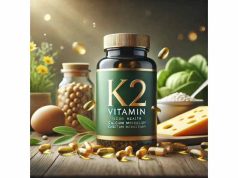
Hesperidin, a bioflavonoid chiefly found in citrus fruits like oranges and lemons, has gained increasing attention for its potential to enhance ocular wellness. Often praised for its antioxidant and anti-inflammatory qualities, hesperidin may help the eyes cope with daily stressors ranging from bright digital screens to exposure to environmental pollutants. Although not as widely recognized as some other eye-supportive nutrients, early research suggests that hesperidin’s impact on circulation and inflammation could be a valuable addition to many vision care regimens. In this article, we’ll explore what makes hesperidin unique, how it supports visual function, and practical tips on integrating it into your daily life.
Table of Contents
- Understanding the Basics: What Is Hesperidin?
- Mechanisms: How Hesperidin Contributes to Visual Acuity
- Essential Advantages of Hesperidin for Ocular Wellbeing
- Best Practices for Incorporating Hesperidin
- Emerging Data and Ongoing Research
- Frequently Asked Questions
- References and Sources
Understanding the Basics: What Is Hesperidin?
Hesperidin is a phytonutrient categorized as a flavanone—a subclass of flavonoids typically occurring in citrus. Discovered in the early 19th century, its name is rooted in “Hesperides,” the nymphs in Greek mythology who guarded a legendary garden of golden apples. It was in these “golden” citrus fruits that hesperidin was first identified and studied for potential health applications.
Natural Occurrence
You can find hesperidin mostly in:
- Oranges and Tangerines: The peels and membranes tend to be especially rich sources.
- Lemons, Limes, and Grapefruits: While containing somewhat lower concentrations, they still provide noteworthy amounts.
- Commercial Supplements: Products standardized to a particular percentage of hesperidin or total citrus bioflavonoids.
Traditional and Contemporary Uses
Historically, people turned to citrus extracts to support healthy circulation and strengthen blood vessels. Modern research further recognizes that hesperidin’s robust antioxidant profile may provide a broader protective scope:
- Vein and Capillary Health: By helping maintain vascular integrity, hesperidin is often used to support healthy veins, potentially reducing swelling in the legs and promoting better blood flow.
- Anti-Inflammatory Effects: It may moderate pro-inflammatory markers, especially when paired with other flavonoids like diosmin.
- Metabolic Regulation: Emerging data suggest it could help promote balanced cholesterol and glucose levels, though more comprehensive trials are needed.
What Makes Hesperidin Stand Out
In the large family of flavonoids, hesperidin is particularly valued for:
- Bioavailability: It’s relatively well-tolerated, though absorption can improve when combined with certain other substances (e.g., piperine or an appropriate fat source).
- Potential Synergy: It often pairs well with vitamin C (ascorbic acid) or other citrus compounds to amplify antioxidant capacity.
Given that vision wellness hinges on strong vascular networks and minimal oxidative stress, hesperidin’s capacity to fortify capillaries and neutralize free radicals is an intriguing angle for further exploration in the context of eye care.
Mechanisms: How Hesperidin Contributes to Visual Acuity
Healthy eyes are contingent on a combination of optimized blood flow, robust tissue structures, and adequate nutrient intake. Because hesperidin exerts effects on multiple physiological systems, it could serve as a valuable ally in preserving and potentially enhancing visual clarity.
1. Fortifying Ocular Circulation
The delicate tissues in your eyes rely on fine blood vessels to supply oxygen and essential nutrients. If these vessels weaken or become obstructed, vision problems may result:
- Strengthening Vascular Walls: Hesperidin is believed to maintain elasticity in blood vessels, lowering the risk of microbleeds or undue leakage that can harm the retina.
- Microcirculation Support: By encouraging efficient blood flow, hesperidin ensures that the retina and lens receive a steady influx of nutrients, thereby reducing stress that can impair vision quality.
2. Countering Oxidative Stress and Inflammation
Ocular tissues are vulnerable to oxidative challenges from sunlight, pollution, and digital screen exposure. In turn, inflammation can degrade retinal cells and expedite degenerative conditions:
- Scavenging Free Radicals: Hesperidin’s antioxidant capacity helps neutralize reactive oxygen species, preventing them from damaging the structural proteins in the lens or retina.
- Modulating Inflammatory Pathways: Some findings suggest hesperidin reduces the expression of pro-inflammatory cytokines, diminishing chronic inflammation that can lead to macular or corneal issues.
3. Stabilizing Collagen and Connective Tissues
Various components in the eye, from the sclera (white outer layer) to the cornea, incorporate collagen and connective proteins for structural integrity:
- Collagen Preservation: Flavonoids like hesperidin can hinder enzymes that degrade collagen, thereby retaining firmness in ocular tissues.
- Tissue Healing: If minor damage occurs, better collagen status speeds up reparative processes and can keep micro-tears in the retina or sclera from becoming severe.
4. Beneficial Influence on Eye Pressure
Elevated intraocular pressure (IOP) is a major risk factor in conditions like glaucoma, which damages the optic nerve. Though research is preliminary, some believe hesperidin’s vasculoprotective qualities might:
- Help Regulate Aqueous Humor Outflow: Healthy vasculature in the eyes can support balanced fluid dynamics, potentially lowering IOP.
- Reduce Pressure-Related Strain: Minimizing local inflammation and oxidative stress can also help preserve nerve fibers.
5. Synergy with Other Eye-Protective Nutrients
Hesperidin often operates hand-in-hand with other dietary components for enhanced ocular resilience:
- Vitamin C and E: These vitamins deliver direct antioxidant actions that complement hesperidin’s vascular benefits.
- Carotenoids (Lutein, Zeaxanthin): They shield the macula from damaging blue light, while hesperidin promotes blood flow to supply these pigments effectively.
Essential Advantages of Hesperidin for Ocular Wellbeing
As you begin to look more closely at nutrient-based approaches to eye care, you’ll see that many revolve around antioxidant support, anti-inflammatory interventions, or vascular maintenance. Hesperidin touches on each of these pillars, leading to a series of potential vision-related benefits.
1. Protection Against Retinal Damage
Your retina, which converts light into neural signals, is susceptible to harm from free radicals and poor circulation:
- Better Blood Flow: By backing the capillary networks, hesperidin can help sustain oxygen and nutrient delivery to photoreceptor cells (rods and cones).
- Less Oxidative Burden: Flavonoid-based antioxidants remove damaging molecules before they degrade sensitive retinal tissues, helping preserve crisp night and color vision.
2. Possible Delay of Macular Degeneration
Age-related macular degeneration (AMD) remains a top cause of vision loss worldwide. While genetics and lifestyle both factor in, a well-nourished retina can stave off or slow progression:
- Anti-Inflammatory Support: Chronic low-grade inflammation in the macula can accelerate AMD changes. Hesperidin’s mild yet consistent anti-inflammatory effect may shield this critical central region.
- Strengthened Vascular Integrity: Minimizing micro-bleeds or fluid accumulation in the macula can maintain sharper central vision.
3. Potential Aid for Diabetic Retinopathy
High blood sugar can degrade small blood vessels and stimulate swelling or abnormal blood vessel growth within the retina:
- Capillary Reinforcement: Hesperidin’s vascular benefits may limit leakage from weakened capillaries in diabetic retinopathy.
- Combating Oxidative Glucose Byproducts: Elevated blood sugar fosters reactive species that harm ocular tissues; hesperidin could help neutralize these.
4. Supporting Lens Transparency
A healthy lens is crucial to focusing light precisely onto the retina. Oxidation or glycation can lead to lens opacification (cataracts):
- Reduced Protein Denaturation: Hesperidin’s antioxidant action can help keep lens proteins from binding abnormally.
- Synergistic with Other Nutrients: Combining hesperidin with vitamins C and E or other lens-friendly compounds might yield improved outcomes in delaying cataract formation.
5. Alleviating Everyday Eye Strain
Modern lifestyles dominated by screens are linked with dryness, redness, and blurred vision from digital eye strain. Though not a direct remedy, hesperidin’s capacity for:
- Decreased Minor Inflammation: Could soothe subtle irritations, especially in synergy with adequate breaks and proper hydration.
- Enhanced Microcirculation: Helps ensure the eye’s tear-producing glands and corneal cells receive sufficient nutrients.
6. Broader Systemic Benefits that Impact Eye Health
Eye health doesn’t exist in a vacuum—conditions like hypertension, high cholesterol, or systemic inflammation can spill over into ocular issues:
- Cardiovascular Support: Some data suggest hesperidin fosters healthy blood pressure and vascular function, indirectly supporting the eyes.
- Metabolic Balance: By assisting in weight management or healthy glucose regulation, hesperidin helps maintain the entire body’s equilibrium, including ocular tissues.
Best Practices for Incorporating Hesperidin
If you’re intrigued by what hesperidin may do for your eyes, the next step is learning how to integrate it into your routine wisely. Whether through diet, supplements, or synergy with other compounds, a few practical considerations can help you optimize results and mitigate risks.
1. Opting for Dietary Sources
For many individuals, the simplest approach is to boost consumption of citrus fruits:
- Oranges, Tangerines, Lemons: Enjoy them fresh or incorporate the zest for a bigger flavonoid punch.
- Citrus Peels: If you use organic produce, adding small amounts of grated peel (zest) to teas or dishes can bolster hesperidin intake.
- Fruit Juices: Keep in mind that while juice can contain hesperidin, it may also be high in sugar. Whole fruits often deliver more fiber and nutrients overall.
2. Selecting the Right Supplement Form
Hesperidin supplements often come in combination with other citrus bioflavonoids like diosmin or quercetin. Some are paired with vitamin C for improved absorption. Key product types include:
- Pure Hesperidin Capsules: Usually standardized to ensure a consistent dose of the flavonoid.
- Citrus Extract Blends: Provide a range of flavonoids, potentially increasing synergy but offering lower individual hesperidin concentrations.
- Complex Eye Formulas: Some specialized products combine hesperidin with lutein, zeaxanthin, or anthocyanins for comprehensive ocular protection.
3. Dosage and Timing Considerations
Research-based dosage suggestions vary, typically ranging from 100 mg to 600 mg of hesperidin daily. However, certain formulations, particularly for vascular health, combine 450 mg of diosmin with 50 mg of hesperidin per serving:
- Moderate Approach: Begin with a middle-of-the-road dose—around 200-300 mg daily—then evaluate how you feel.
- Meal Pairing: Consuming hesperidin with meals can promote better absorption, especially if the product includes a fat source or is taken alongside healthy fats.
- Consultation: Always check with a healthcare provider if you have special conditions (e.g., diabetes, clotting disorders) or if you’re unsure about dosage.
4. Combining with Other Key Nutrients
Because hesperidin often works best in synergy, consider pairing it with:
- Omega-3 Fatty Acids: Good for tear film integrity and anti-inflammatory effects on the retina.
- Lutein & Zeaxanthin: Focus on macular protection and filtering harmful blue light.
- Zinc & Vitamin A: Essential for the retina’s photoreceptor functioning and overall night vision.
- Vitamin C: A powerful partner to hesperidin, further inhibiting oxidative stress.
5. Lifestyle Support for Stronger Vision
No supplement alone can offset harmful habits. For maximum ocular benefits:
- Schedule Eye Breaks: The 20-20-20 rule is an easy guideline—look away from screens every 20 minutes at something 20 feet away for 20 seconds to reduce digital fatigue.
- Stay Hydrated: Proper fluid intake ensures that your eyes stay moist and less prone to irritation.
- Adequate Sleep: The eyes repair and regenerate at night. Chronic sleep deprivation can degrade ocular function over time.
- Protect from UV and Blue Light: Wear sunglasses in bright environments and consider screens or glasses that filter harsh blue rays to limit damage.
6. Potential Side Effects and Cautions
Hesperidin is generally regarded as safe when used appropriately. Still, watch out for:
- Gastrointestinal Upset: Mild bloating or stomach discomfort can occasionally occur.
- Allergic Reactions: Rare, but possible if you have a history of citrus allergies.
- Medication Interactions: If you use blood thinners or other circulatory meds, consult a doctor to ensure no conflicting effects.
Emerging Data and Ongoing Research
While hesperidin’s antioxidant and vascular properties are well-documented in laboratory experiments and smaller clinical trials, large-scale human studies specifically targeting eye health remain less frequent. Nonetheless, many lines of research point toward promising synergies between hesperidin and ocular function.
1. Retinal Protection in Animal Models
Preclinical tests with rodents demonstrate that hesperidin can protect photoreceptors from oxidative insults. By lessening inflammation and improving vascular perfusion in retina models, these findings suggest:
- Reduced Risk of Photoreceptor Degeneration: This is especially relevant in conditions akin to retinitis pigmentosa or advanced AMD.
- Longer Preservation of Night and Peripheral Vision: Enhanced rod cell function translates to more reliable low-light vision.
2. Antidiabetic and Ocular Benefits
Several small-scale studies highlight hesperidin’s capability to moderate blood glucose and insulin resistance, at least in animals or in early-stage clinical contexts:
- Diabetic Retinopathy: By promoting stable blood sugar levels and reinforcing microvascular networks, hesperidin may help slow or mitigate early retinal changes.
- Inflammatory Marker Reduction: Markers like TNF-alpha, IL-6, and IL-1beta also appear downregulated, further backing the herb’s anti-inflammatory credentials.
3. Ocular Pressure and Glaucoma Investigations
Though not conclusive, certain experiments explore whether hesperidin’s vascular effects extend to fluid dynamics within the eye:
- Intraocular Pressure Stability: By supporting healthy aqueous humor flow and drainage, hesperidin could be an adjunct for those at risk of elevated IOP.
- Protection of Optic Nerve Fibers: Some preliminary data indicates that robust blood flow fosters nerve cell longevity, but human trials are vital to confirm significant correlation.
4. Synergy with Other Flavonoids
Much of the groundbreaking research looks at how hesperidin interacts with quercetin, rutin, or anthocyanins:
- Enhanced Efficacy: Together, these flavonoids may produce a layering effect—addressing multiple inflammatory and oxidative pathways concurrently.
- Improved Absorption: Certain combinations improve each other’s bioavailability, ensuring more consistent coverage in ocular tissues.
5. Ongoing Clinical Trials
Currently, the emphasis remains on hesperidin’s role in vein health, metabolic syndrome, and heart disease. However, some investigations also incorporate ocular endpoints. As these trials mature, we may see:
- Larger Groups: Involving hundreds of participants with varied backgrounds, improving the reliability of results.
- Longer Follow-Up: Observing how hesperidin’s effects manifest over months or even years in terms of sustained eye health and stable vision test readings.
Frequently Asked Questions
Is hesperidin alone enough to safeguard my vision?
While hesperidin helps reinforce vascular integrity and reduce oxidative stress, holistic eye care usually requires multiple strategies—like a nutrient-rich diet, protective eyewear, and routine eye exams. Consider hesperidin as a supportive element rather than a stand-alone fix.
Can consuming more citrus fruit fully replace hesperidin supplements?
Whole fruits deliver benefits beyond just hesperidin, including fiber, vitamins, and additional flavonoids. Nonetheless, supplementation can offer a concentrated, standardized dose. Opt for a balanced approach: incorporate citrus into your diet and use supplements if extra support is needed.
How soon might I observe any vision improvements from hesperidin?
Timing can vary. Some people notice subtle relief in eye fatigue or dryness within several weeks. Significant protective effects on retinal health—like stalling minor degenerative changes—often become apparent over months to years of consistent use.
Are there any notable side effects from hesperidin for eye health?
When used properly, adverse effects are minimal. Gastrointestinal discomfort or rare allergic reactions are possible. If you have circulatory conditions or take blood-thinning medications, consult with a healthcare provider before starting any new supplement.
What dosage is typically recommended for eye benefits?
Studies for ocular outcomes haven’t set definitive guidelines. Generally, 100–600 mg daily is common in research focusing on vascular issues. If combined with other flavonoids, your overall intake of each compound may differ. Always adhere to the product’s instructions or professional advice.
References and Sources
- Kim, H., et al. The Protective Role of Hesperidin Against Oxidative Stress in Retinal Cells. Journal of Nutritional Biochemistry, 2018; 56: 111–119.
- Habauzit, V., & Morand, C. Evidence on the Protective Effects of Dietary Flavanols on Vascular Health. BioFactors, 2012; 38(1): 77–86.
- Miyake, Y., et al. Hesperidin as a Promising Bioactive for Age-Related Diseases. Nutrients, 2015; 7(9): 7729–7747.
- Valls, R. M., et al. Clinical Evidence of the Effects of Polyphenols on Cardiovascular Health. British Journal of Clinical Pharmacology, 2015; 79(6): 769–782.
- Boateng, J., & Verghese, M. Flavonoid-Rich Foods in Eye Health: A Comprehensive Review. Ophthalmic Research, 2020; 63(3): 173–189.
- Cheng, Y. F., & Chen, Y. Potential Use of Hesperetin and Hesperidin in Treating Diabetic Complications. Frontiers in Pharmacology, 2019; 10: 797.
Disclaimer:
This article is for educational purposes only and does not substitute professional medical advice. Always talk with a qualified healthcare provider before making significant changes to your diet, supplement regimen, or treatment plan—particularly if you have existing health conditions or use prescription medications.
If you found this piece on hesperidin’s vision benefits helpful, please share it on Facebook, X (formerly Twitter), or any social channel you prefer. Follow us online for more tips and insights on maintaining clear, vibrant eyesight and overall wellness!










